
Located in Eastern Europe, Moldova is bordered on the west and southwest by Romania and on the north, south, and east by Ukraine. Most of its territory lies in Bessarabia region, between the area's two main rivers, the Nistru and the Prut. The Nistru forms a small part of Moldova's border with Ukraine in the northeast and southeast, but it mainly flows through the eastern part of the country, separating Bessarabia and Transnistria. The Prut River forms Moldova's entire western boundary with Romania. The Danube touches the Moldovan border at its southernmost tip, and forms the border for 200 metres (656 ft).
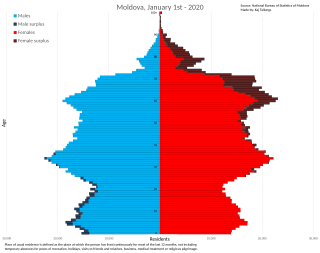
Demographic features of the population of Republic of Moldova include distribution, ethnicity, languages, religious affiliation and other statistical data.
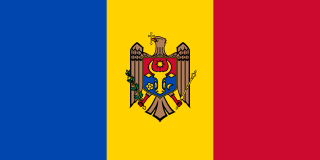
Moldova, officially the Republic of Moldova, is a landlocked country in Eastern Europe, on the northeastern corner of the Balkans. The country spans a total of 33,483 km2 (12,928 sq mi) and has a population of approximately 2.42 million as of January 2024. Moldova is bordered by Romania to the west and Ukraine to the north, east, and south. The unrecognised breakaway state of Transnistria lies across the Dniester river on the country's eastern border with Ukraine. Moldova is a unitary parliamentary representative democratic republic with its capital in Chișinău, the country's largest city and main cultural and commercial centre.

Bender or Bendery, also known as Tighina, is a city within the internationally recognized borders of Moldova under de facto control of the unrecognized Pridnestrovian Moldavian Republic (Transnistria) (PMR) since 1992. It is located on the western bank of the river Dniester in the historical region of Bessarabia.
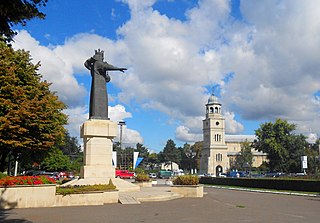
Bălți is a city in Moldova. It is the second-largest city in terms of population, area and economic importance, after Chișinău. The city holds the status of municipiu. Sometimes called "the northern capital", it is a major industrial, cultural and commercial centre and transportation hub in the north of the country. It is situated 127 kilometres (79 mi) north of the capital Chișinău, and is located on the river Răut, a tributary of the Dniester, on a hilly landscape in the Bălți steppe.
Soroca is a city and municipality in Moldova, situated on the Dniester River about 160 km (99 mi) north of Chișinău. It is the administrative center of the Soroca District. Before the Holocaust, most of the population was Jewish.
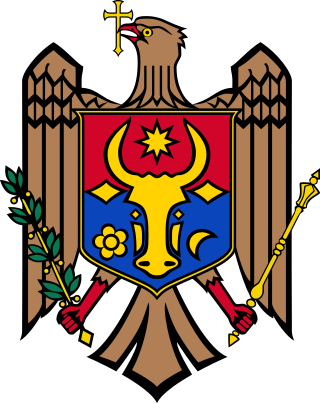
Moldova is divided administratively into two levels:

Cimișlia is a town located in the southern part of Moldova situated on the banks of the Cogâlnic River, between the capital of Chișinău and the autonomous territorial unit of Gagauzia. Cimişlia had a population of 11,997 according to the 2014 census. The town is also the seat/administrative center of Cimișlia District. It also administers three villages as follows: Bogdanovca Nouă, Bogdanovca Veche, and Dimitrovca.

Briceni is a district in the north-west of Moldova, with the administrative center at Briceni. The other major city is Lipcani. As of January 1, 2011, its population was 75,300.

Fălești is a district in the north of Moldova, with the administrative center at Fălești. As of January 1, 2011, its population was 92,600.
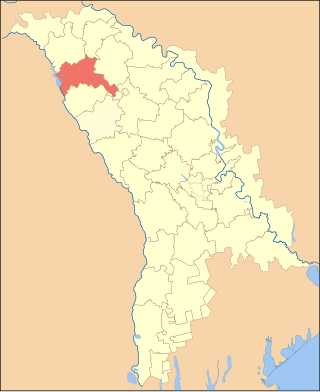
Rîșcani is a district in the north-west of Moldova, with the administrative center at Rîșcani. The other major city is Costești. As of 1 January 2011, its population was 70,000.

Ialoveni is a district in the central part of Moldova, with the administrative center at Ialoveni. As of 2014, its population was 93,154.

Strășeni is an administrative district in the central part of Moldova. Its administrative center and leading city is Strășeni. As of 1 January 2011, its population was 91,100. The other principal town is Bucovăț, 26 km (16 mi) to the north of the Moldovan capital. Otherwise, the district is divided between rural communities.

Leova is a city in Moldova, located 92 km southwest of the national capital, Chișinău. It is the administrative center of Leova District. The city is situated on the east bank of the river Prut bordering Romania.

The Dubăsari District is a district in the east of Moldova, with the administrative center at Cocieri. As of January 1, 2011, its population was 35,200. This does not include the 715 people that live in the village of Roghi, which is controlled by the breakaway Tiraspol authorities. Dubăsari means ferry-arks.
Horodca is a village in Ialoveni District, Moldova.

Trușeni is a commune and village in the Buiucani Sector of the Chisinau Municipality, Moldova. It had a population of 10,380 at the 2014 Moldovan Census, and is a northwest suburb of Chișinău. The commune is composed of two villages, Dumbrava and Trușeni.
Puhăceni is a village and commune in Anenii Noi district, on the banks of the largest river in Moldova. - Nistru. The village has a documented history since 1523. It is located about 65 km from Chisinau, the capital of Moldova, and 33 km from the district centre of Anenii Noi. With an area of approximately 2.37 square kilometres and a perimeter of 5.88 km, the village of Puhăceni offers a picturesque setting for both its inhabitants and visitors.
Văsieni is a village in Ialoveni District, Moldova.

Currently, there are three defined types of public roads in the Republic of Moldova:


















